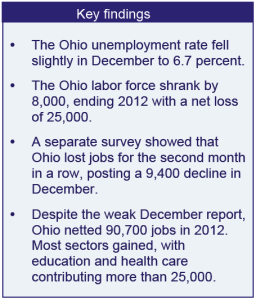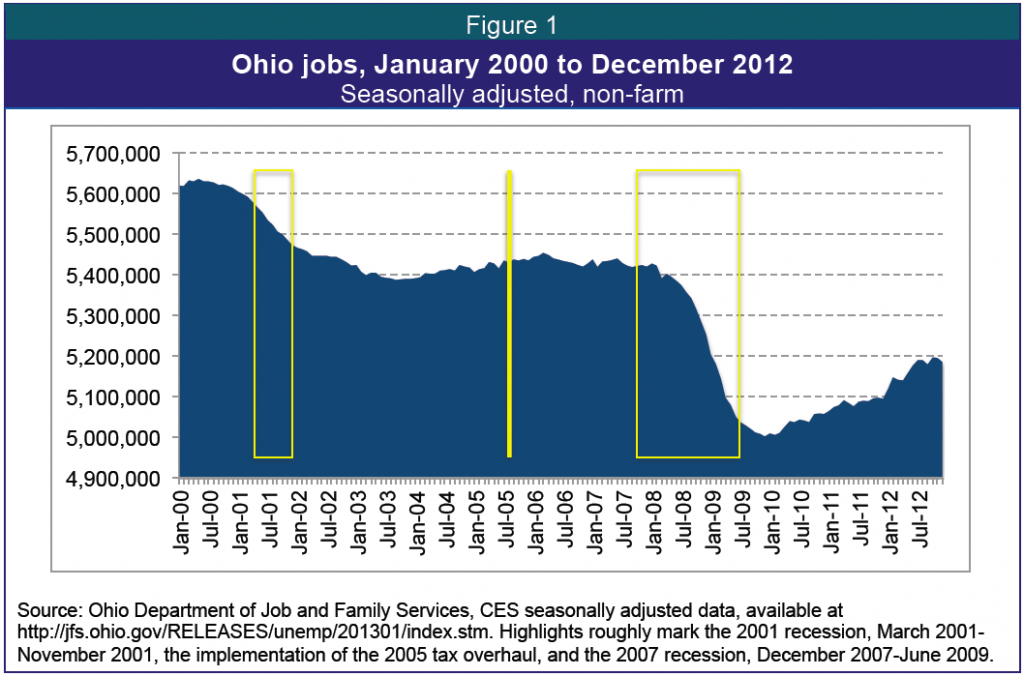
Precarious recovery: Ohio’s final jobs report for 2012 shows decline in unemployment, but also in jobs, labor force
January 18, 2013
Precarious recovery: Ohio’s final jobs report for 2012 shows decline in unemployment, but also in jobs, labor force
January 18, 2013
Press releaseToday’s numbers show the precarious state of the economic recovery in Ohio. The drop in unemployment was caused as much by a shrinking labor force as by a decline in joblessness.
Download report
There was mixed news for Ohio’s job market as 2012  ended, but two surveys released today by the Ohio Department of Job and Family Services (ODJFS) showed the precarious state of the economic recovery. The unemployment rate continued to decline in December, but Ohio saw a drop in the labor force and another decline in the number of jobs.
ended, but two surveys released today by the Ohio Department of Job and Family Services (ODJFS) showed the precarious state of the economic recovery. The unemployment rate continued to decline in December, but Ohio saw a drop in the labor force and another decline in the number of jobs.
ODJFS’s survey of households shows that the unemployment rate fell by 0.1 percent to 6.7 percent. Unfortunately, this drop was caused as much by a shrinking labor force as by a decline in unemployment.
A separate survey, the establishment survey, which provides the job count by surveying firms and generally carries more statistical weight, showed that Ohio lost 9,400 jobs in December. Virtually the entire decline occurred in the service sector.
The monthly numbers are always preliminary and subject to revision, so it is ill-advised to make too much of month-to-month changes. November’s originally reported gain of 1,600 jobs was revised this month to show a loss of 1,500 jobs, making December the second month of job loss in a row.
Conflicting survey data are not unusual. The surveys may tell conflicting stories because they survey different groups. The establishment survey, which tallies the number of jobs, carries more statistical weight because it is based on a much larger sample size than the household survey, which generates data for the unemployment rate and labor force numbers.
Today the surveys, while contradictory, are indicating how precarious our recovery is. The number of jobless workers and the unemployment rate have fallen, but far too many Ohioans are falling out of the labor force and our job gains continue to be tenuous.
Job growth trends
In 2012, Ohio gained 90,700 jobs, or 1.8 percent. While this is an improvement over the 2011 growth rate of 0.7 percent, Ohio still has 235,400 fewer jobs than when the recession started in 2007.
Figure 1 highlights changes in the Ohio job market from key points in time, including the recessions that began in 2001 and 2007, and the 2005 approval of a major state tax overhaul, which promised speedier economic growth. These figures include the latest seasonally adjusted data from the monthly survey of employers (Current Employer Survey) done by ODJFS in cooperation with the U.S. Bureau of Labor Statistics.
Table 1 details these changes. Not only is the state struggling to recover from the 2007 recession, Ohio never recovered from the 2001 recession, having lost more than 400,000 jobs since that recession began. The state job count is also down more than 4.0 percent, 229,900 jobs, since the approval of the 2005 tax overhaul. Ohio has made progress, but the state is a long way from recovery.
Over the last 12 months, most sectors experienced growth. Education and health care contributed the most jobs, more than 25,000. Trade, transport and utilities added 16,800 jobs, while manufacturing and professional and business services each contributed more than 15,000.
A few sectors continued to lag behind. Public workers had the largest net losses, with nearly all of the loss coming from local government workers (-5,000). The information sector declined by 1,300 jobs, and mining and logging lost 800 jobs.
Labor force declines
The household survey showed that the state’s labor force, the number of people working or actively looking for work, declined in December by 8,000. This drop erases more than half of the gains made since September. In the last 12 months, Ohio’s labor force shrank by 25,000. Figure 3 shows the remarkable decline of Ohio’s civilian labor force since the end of the recession in 2009.
Some of the people leaving the labor force are choosing retirement, or to work in the home taking care of aging family member or children. Others may be returning to school or training for a new career. Some people, particularly during prolonged periods of high unemployment and low job growth, become too discouraged to continue searching, applying and receiving rejections and are no longer counted as part of the labor force.
In periods of robust recovery, there is often a slight increase in the unemployment rate as job growth and improving job prospects pull workers back into the labor force. But the state’s labor force is not growing on a sustained basis. Even with Ohio’s gains, there are simply too few jobs for the number of workers seeking work. If every job listed on Ohio Means Jobs were filled today (92,132), there would still be more than 295,000 officially unemployed Ohioans. Ohio Means Jobs is the state sponsored jobs bank that pulls job listings and resumes from several online job databases
WARN
The Worker Adjustment and Retraining Notification Act (WARN) protects workers and communities by requiring employers with more than 100 employees to provide 60 days’ advance notice of plant closures or mass layoffs. Federal, state, and local government entities are not covered. WARN triggers rapid response services, which can include layoff aversion, training and dislocated worker assistance. As Table 2 shows, 6 WARN Act notices were filed with ODJFS in December, impacting 537 workers, 61 of whom are in a union.
Conclusion
Ohio has made progress but we are a long way from a full recovery. Elected officials at the state and federal level should avoid decisions that threaten to throw this tentative recovery into reverse. Policymakers should craft budgets that support good job growth, and strengthen our public investments.
JobWatch is an ongoing project of the Economic Policy Institute (www.epi.org) and Policy Matters Ohio, (www.policymattersohio.org). Both are nonprofit policy research institutes
Tags
2013Hannah HalbertJobWatchWork & WagesPhoto Gallery
1 of 22



